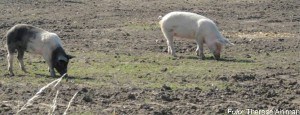Animal welfare in organic pig production - does leg health improve by change of sire breed?
Project responsible: Anna Wallenbeck, Department of Animal Breeding and Genetics, SLU.
Project member: Maria Alarik, Swedish Rural Economy and Agricultural Societies.
Collaboration: Eva Heldmer, Swedish Animal Health Service.
The overall aim with this project is to assess possibilities to improve pig leg health in organic production by change in sire breed.
In most cases, the pigs raised in organic herds are of the same breeds as used in conventional herds. These breeds are selected for high production in conventional production environments. The production environment partly differs between organic and conventional production and the stress on the joints are often higher for pigs in organic production environments, leading to more severe forms of osteochondrosis.
At present, the most commonly used sire breeds are Hampshire in Sweden and Duroc in Norway, but both breeds are available for producers in both countries. There are scientific and practical experiences indicating that progenies of Duroc boars have better leg health in outdoor production than progenies of Hampshire boars, and Duroc would thus be more suitable for organic production. In order to investigate this we will study:
- exterior,
- leg conformation and
- locomotion during the growing-finishing period,
- remarks related to leg health at slaughter and
- production
in 500 Hampsire- and 500 Duroc-offspring raised in organic herds.
